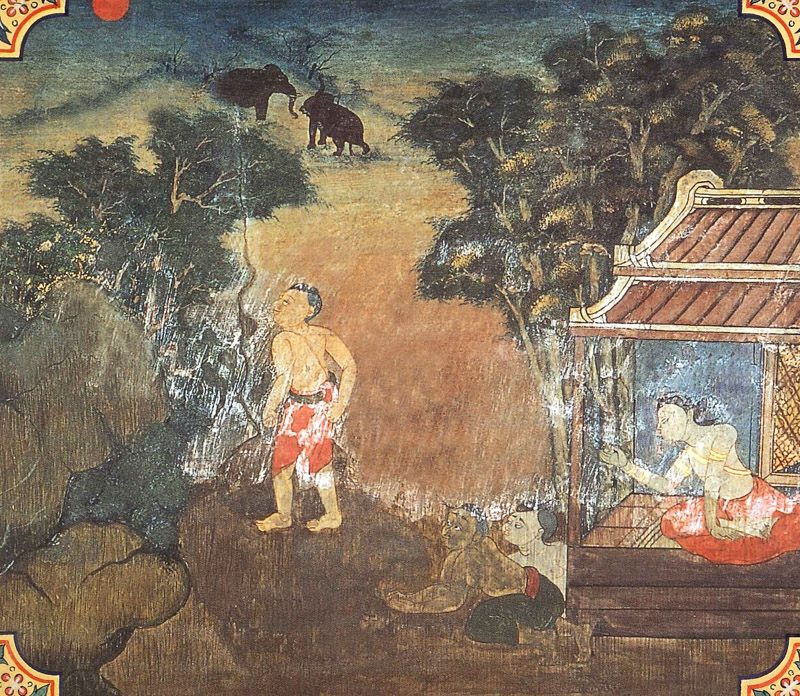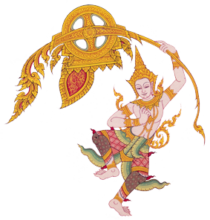
The Bodhisatta was once a king’s chaplain. The queen had asked the king to be fully faithful to her. Though he had initially refused, she persisted, and eventually he agreed. He stopped even looking at any of his sixteen thousand dancing girls and never broke his vow.
When the king needed to travel to the border region to oversee a campaign by his troops against bandits, the queen stayed behind. At her request, the king sent a messenger back to the palace after every league of travel to deliver a letter and check on her. During the journey there and back, he sent sixty-four messengers, and the queen seduced and sinned with each of them. And just before the king returned, the queen demanded the Bodhisatta sleep with her. When he refused her advances, she said she would have him killed.
Before the king came to see her in her bedchamber, the queen scratched herself and feigned illness. When the king asked what was wrong, she lied, saying the Bodhisatta had demanded sex and beat her when she refused. Fuming with rage, the king demanded his soldiers arrest and behead him without delay. As he was being led through the city to the execution place, the Bodhisatta convinced the king’s servants to take him to the king before he died so he could tell where great treasures were buried.
When he faced the king, the Bodhisatta declared his innocence and his righteousness, saying he had never so much as killed an ant, stole a blade of grass, lusted over another man’s wife, spoken an untruth even in jest, or tasted a drop of strong liquor. He explained what had really happened between the queen and him and asked the king to summon her and the messengers to uncover the truth about her behavior. The queen confessed her transgressions, and the king ordered the messengers beheaded instead of the Bodhisatta. The Bodhisatta suggested the king pardon them since they had been compelled by the queen, and he should forgive her because being unfaithful is the innate nature of all women and they cannot control themselves. The king accepted this wisdom and decided to be merciful, giving each messenger a place to live. After this, the Bodhisatta left the city to live as an ascetic in the Himalayas.
In the Lifetime of the Buddha
As the Buddha’s fame grew and his disciples multiplied, other religious teachers lost most of their followers. Upset over this, some heretics enlisted a beautiful woman named Cinca-Manavika to destroy the Buddha’s reputation so they would receive more praise and alms. The scheme she devised began with her sleeping in the countryside near the Buddha’s monastery, then walking toward the city early in the morning so the people she passed would believe she had actually been spending the night there. After four months of this, she started wrapping cloth around her stomach and announced that she was pregnant with the Buddha’s child. Some people believed her.
As the ninth month approached, Cinca-Manavika added pieces of wood to her belly bundle and beat her hands and feet with the jawbone of an ox to induce swelling. She then walked up to the Buddha during a sermon and cursed him for having a sweet voice but bad behavior. As she publicly denounced him for denying being with her and for not providing a chamber to stay in until she gave birth, the throne of Indra, king of the gods, became warm and he divined what was happening. He and four other gods came to earth in the form of mice and gnawed through the ropes that held Cinca-Manavika’s fake stomach up: The wood fell down, severing her toes and revealing her deceit. As she fled the Buddha’s angry followers, the ground split open and the flames of hell dragged her down. The religious leaders who had helped her lost what little support they still had.
The wicked queen was an earlier birth of Cinca-Manavika, and after her lie was exposed, the Buddha told this story so his disciples knew this was not the first time she had made false accusations against him.
The king was an earlier birth of Ananda, one of the Buddha’s top disciples.
